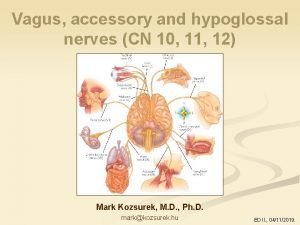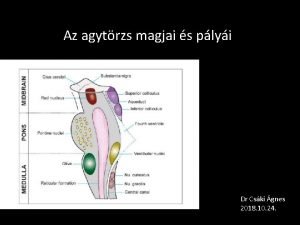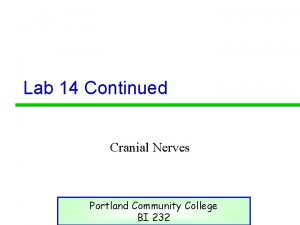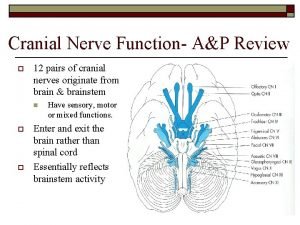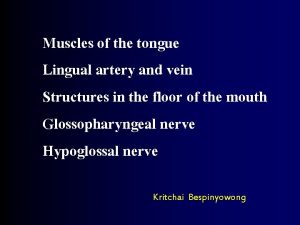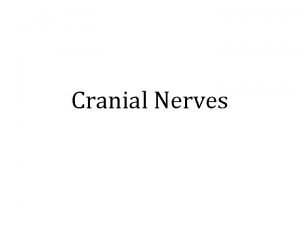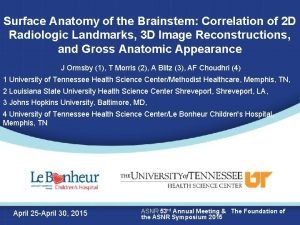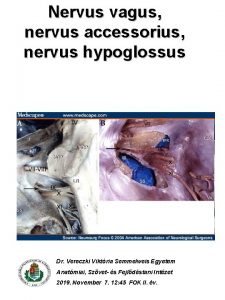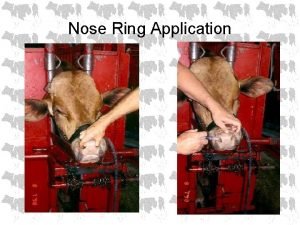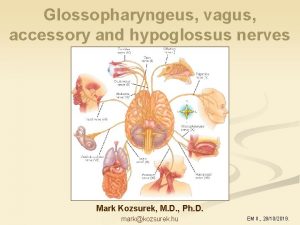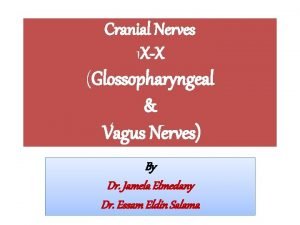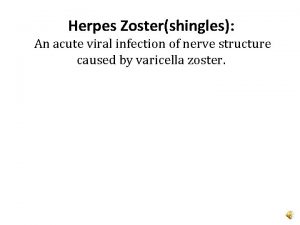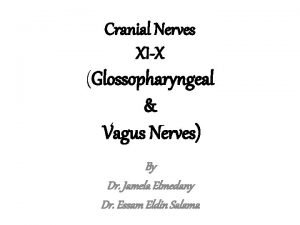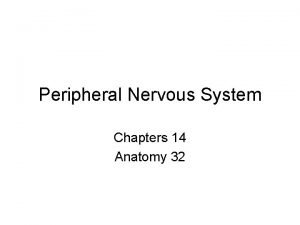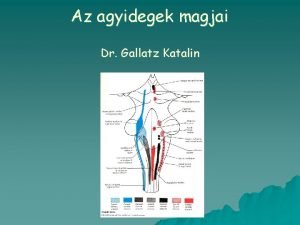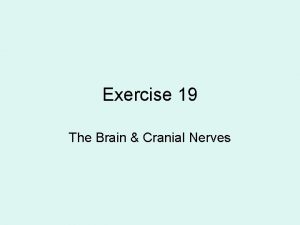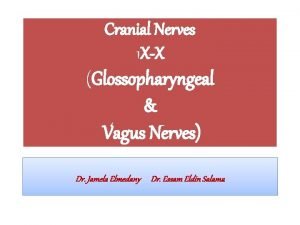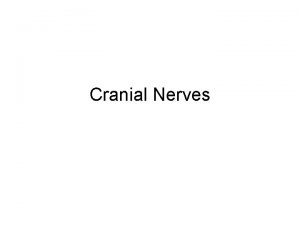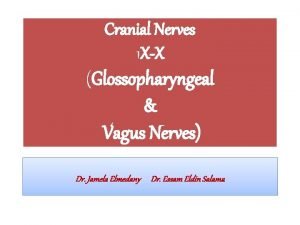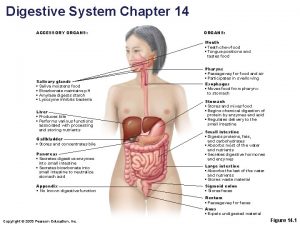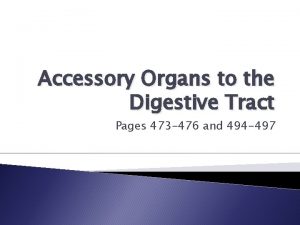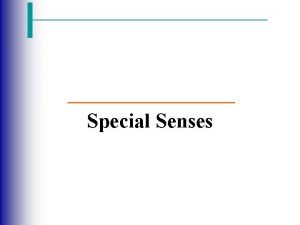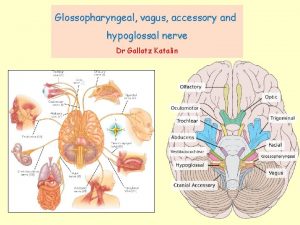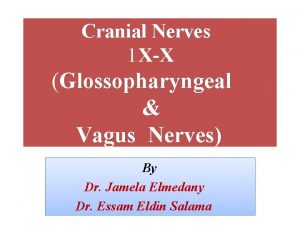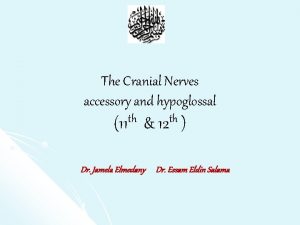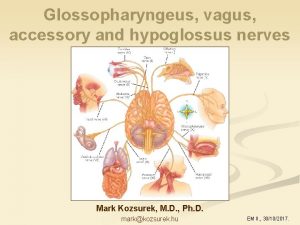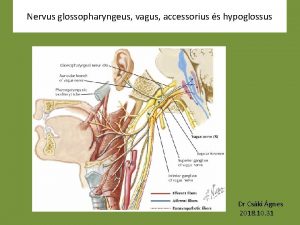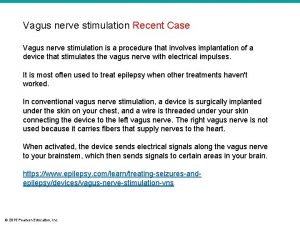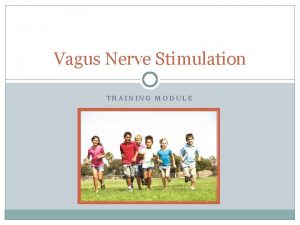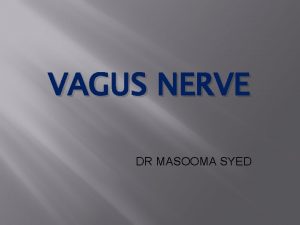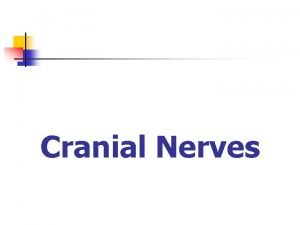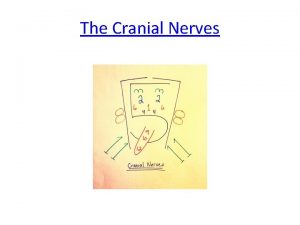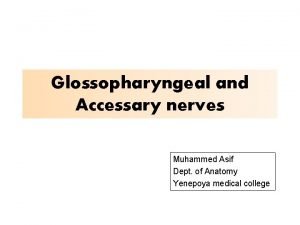Glossopharyngeal vagus accessory and hypoglossal nerves Dr Cski
































- Slides: 32

Glossopharyngeal, vagus, accessory and hypoglossal nerves Dr Csáki Ágnes 2018. 10. 30

Efferent: motor fibers from nuclei toward the perifery GSE - general somatic efferent n. (Somatomotor nuclei or dorsomedial group) (III, IV, VI, XII) SVE – special visceral efferent n. (Branchialmotor nuclei or ventrolateral group ) (V, VII, IX-X-XI) GVE – general visceral efferent n. (visceromotor or parasympathetic n. ) Edinger – Westphal nucleus or oculomotor accessory nucleus (III) Superior salivatory nucleus (VII) Inferior salivatory nucleus (IX) Nucleus dorsalis nervi vagi ( nucl. medialis alae cinereae) (X) Afferent: sensory fibers to nuclei from where the ascending pathways start GVA – general visceral afferent n. (General viscerosensor) Nucleus lateralis alae cinereae (nucl of solitary tract )( IX, X) SVA – special visceral afferent n. (Special viscerosensor: taste) Nucleus of solitary tract (VII, IX, X) GSA – general somatic afferent n. (General somatosensor) Pontine nucleus of V. (principal or main sensory nucleus) - epicritic sensibility ! Mesencephalic nucleus of V. - reflex arc!! Spinal tract nucleus of V. - protopathic sensibility! SSA – special somatic afferent n. (Special somatosensor) Dorsal and ventral cochlear nucleus (VIII) Superior, medial, lateral and inferior vestibular nucleus (VIII)

Nucleus dorsalis nervi vagi ( nucl. medialis alae cinereae) Nucleus lateralis alae cinereae nucleus solitarius Nucleus tractus solitarii Nucleus dorsalis nervi vagi ( nucl. medialis alae cinereae)

Hypoglossal nerve N. XII nucleus: Hypoglossal nucl. /GSE /somatomotor/dorsomedial group (hypoglossal triangle in the IV. ventricle) exit from the brain: medial paraolivary sulcus exit from the skull: hypoglossal canal branches: (radix superior ansae cervicalis from C 1) lingual branches (extrinsic and intrinsic muscles and geniohyoid m. )

corticobulbar afferents are crossed: Upper motor neuron lesion causes paresis (weakness) of the opposite side, tip of the tongue shows away from the lesion, the tongue deviates to the weak side.

Glossopharyngeal, vagus, accessory

Accessory nerve (N. XI. ) Nuclei: -Nucleus ambiguus /SVE/branchiomotor - cranial root -ventral horn of C 1 -C 6 – spinal root exit from the brain: lateral paraolivary sulcus exit from the skull: jugular foramen pars nervosa cranial root (for. jugulare) spinal root (for. magnum into the skull; for jugulare) branches: internal br. to n. X. (larynx) external br. (sternocleidomastoid and trapezius m. )

Spinal and cranial roots of the accessory nerve


Glossopharyngeal nerve (N. IX) It is a mixed nerve and contains five components. general visceral efferent GVE to supply the secretion of the parotid gland Inf. salivary nucleus special visceral efferent SVE stylopharyngeus Nucleus ambiguus general visceral afferent GVA carotid glomus and the carotid sinus; Nucleus lateralis alae cinereae special (taste) visceral afferent SVA taste buds of posterior 1/3 of the tongue nucleus solitarius The general somatic afferent GSA posterior surface of the auricle, mucous membrane of the pharynx, auditory tube, tympanic cavity, the posterior 1/3 of the tongue, spinal tract nucleus of V.

Nuclei of the N. IX: Nucleus ambiguus /SVE Inferior salivatory n. /GVE Nucleus of solitary tract /SVA Nucleus lateralis alae cinereae /GVA Spinal nucleus of V. /GSA Nucleus lateralis alae cinereae Cross section of the bulb

Branches of the N. IX: 1. tympanic n. (fossula petrosa - tympanic canal - tympanic cavity , mixed n. GSA, GVE) (GVE) lesser petrosal n. toward the otic ggl, the postganglionic fibers are so called „guest fibers „ of the auriculotemporal nerve and supply the parotis (GSA) auditory tube 2. auricular br. sensory-GSA and Nucleus lateralis alae cinereae Inferior salivatory n. /GVE Spinal nucleus of V. /GSA

branches of the N. IX : 1. tympanic n. (mixed n. GSA, GVE)-tympanic cavity (GVE) lesser petrosal n. !!! toward the otic ggl (auriculotemporal nerve) (GSA) auditory tube 2. auricular br – sensory-GSA 3. stylopharyngeus n. – motor-SVE 4. branch to the carotid sinus – sensory -GVA-baro and chemoreceptors and Nucleus lateralis alae cinereae Inferior salivatory n. /GVE Spinal nucleus of V. /GSA Nucleus ambiguus /SVE Nucleus lateralis alae cinereae /GVA

INTEROCEPTORS including internal nociceptors, chemoreceptors, and mechanoreceptors, inform the CNS about the internal state of the body. The carotid body, a specialized chemoreceptor for detecting carbon dioxide (in a hypoxic state) or to a lesser extent low blood p. H resulting in increased respiration, is associated with afferent axons of CN IX that project to the caudal nucleus solitarius in the medulla. The carotid sinus, a thin-walled region of the carotid artery, contains encapsulated and bare nerve endings that act as stretch receptors. These stretch receptors respond to increased arterial pressure as baroreceptors, send primary afferents to the caudal nucleus solitarius via CN IX, and elicit reflex bradycardia and decrease in blood pressure.

branches of the N. IX : 1. tympanic n. (mixed n. GSA, GVE)-tympanic cavity (GVE) lesser petrosal n. !!! toward the otic ggl (auriculotemporal nerve) (GSA) auditory tube 2. auricular br. GSA 3. stylopharyngeus n. – motor-SVE 4. branch to the carotid sinus – GVA-baro and chemoreceptors 5. tonsillary br. - (GSA, SVA-taste)-sensory 6. lingual br. - (GSA, SVA-taste)-sensory 7. pharyngeal branches to the pharyngeal plexus – GVA -sensory Inferior salivatory n. /GVE Spinal nucleus of V. /GSA Nucleus ambiguus /SVE Nucleus lateralis alae cinereae /GVA Nucleus of solitary tract /SVA

Summary of the branches of the N. IX 1. tympanic n. (mixed n. GSA, GVE)-tympanic cavity (GVE) lesser petrosal n. !!! toward the otic ggl (auriculotemporal nerve) (GSA) auditory tube 2. auricular br. GSA 3. stylopharyngeus n. – motor-SVE 4. branch to the carotid sinus – GVA-baro and chemoreceptors 5. tonsillary br. - (GSA, SVA-taste)-sensory 6. lingual br. - (GSA, SVA-taste)-sensory 7. pharyngeal branches to the pharyngeal plexus – GVA -sensory Nucleus ambiguus /SVE Inferior salivatory n. /GVE Nucleus of solitary tract /SVA Nucleus lateralis alae cinereae /GVA Spinal nucleus of V. /GSA

ganglia: superior ggl (foramen jugulare) inferior ggl (fossula petrosa) somatosensory somato and viscerosensory otic ggl parasymp ggl

Vagus nerve (N. X. ) It is a mixed nerve and contains five components. -Nucleus lateralis alae cinereae /GVA/general viscerosensor -Nucleus of solitary tract /SVA/special viscerosensor /taste

Vagus nerve (N. X. ) nuclei: -Nucleus ambiguus /SVE/somatomotor/dorsolateral group -Nucleus dorsalis nervi vagi (or nucl. medialis alae cinereae /GVE)/visceromotor -Nucleus lateralis alae cinereae /GVA/general viscerosensor -Nucleus of solitary tract /SVA/special viscerosensor /taste -Spinal nucleus of V. /GSA/somatosensor for pain exit from the brain: lateral paraolivary sulcus exit from the skull: jugular foramen pars nervosa ganglia: superior ggl (near the foramen jugulare) somatosensory cells inferior ggl (at C 1 -2, 1, 5 cm long) somato and viscerosensory ggl. in the submucose and myenteric plexuses parasymp ggl

Nuclei of the N. X: -Nucleus ambiguus /SVE/somatomotor/dorsolateral group -Nucleus dorsalis nervi vagi (or nucl. medialis alae cinereae /GVE)/visceromotor -Nucleus lateralis alae cinereae /GVA/general viscerosensor -Nucleus of solitary tract /SVA/special viscerosensor /taste -Spinal nucleus of V. /GSA/somatosensor for pain

Branches of the vagus: Neck: 1. post meningeal branch (infratentorial sensation) 2. auricular branch (ext. acust. meatus: reflex!) 3. pharyngeal branches (with the int. branches of XI) 4. superior laryngeal n. 5. cervical cardiac superior and inferior 6. recurrent (inferior) laryngeal n.

Branches of the vagus: Thorax. : 1. thoracic cardiac br 2. bronchial br. 3. pericardiac br 4. esophageal br. Abdomen: gastric, hepatic, celiac small and arge intestine branches as far as the left colic flexure and renal

Esophageal plexus, anterior and posterior vagal trunk

Hepatic branches of the vagus nerve are primarily derived from the left vagus nerve. These branches join the hepatic plexus which innervates the liver.

Celiac branches of the vagus nerve are primarily derived from the right vagus nerve. These branches join the celiac plexus, which innervates the pancreas, kidneys, spleens and suprarenal bodies and intestine




Thanks for your attention! Crossman, A. R. Neuroanatomy, illustrated colour text, 2010, Elsevier Barr, M. L. , Kiernan, J. A. The Human Nervous System. An Anatomical Viewpoint. Philadelphia, 1993. Burt, A. M. , Textbook of Neuroanatomy. 1993. W. B. Saunders Company Kahle, W. , Leonhardt, H. , Platzer, W. Color Atlas/Text of Human Anatomy, Vol. 3. Nervous System and Sensory Organs. Stuttgart, New York, 1993.



 Cannon-böhm point
Cannon-böhm point Tractus occipito temporo pontinus
Tractus occipito temporo pontinus Hypoglossal nerve test
Hypoglossal nerve test Cn xi test
Cn xi test Lingual artery and vein
Lingual artery and vein Labeling cranial nerves
Labeling cranial nerves Hypoglossal nerve damage
Hypoglossal nerve damage Sulcus basilaris
Sulcus basilaris Nervus laryngeus
Nervus laryngeus Hypoglossal canal
Hypoglossal canal Vagus indigestion in cattle
Vagus indigestion in cattle Whats lap band surgery
Whats lap band surgery L
L Glossopharyngeus
Glossopharyngeus Lesions of vagus nerve
Lesions of vagus nerve Vagus nerve shingles
Vagus nerve shingles Vagus nerve components
Vagus nerve components Visceral referral patterns
Visceral referral patterns Dr gallatz katalin
Dr gallatz katalin Caregivers
Caregivers Medial longitudinal fasciculus
Medial longitudinal fasciculus What is vagus nerve
What is vagus nerve Hlavové nervy
Hlavové nervy Nerve ganglia
Nerve ganglia Glossopharyngeal nerve branches
Glossopharyngeal nerve branches Glossopharyngeal nerve
Glossopharyngeal nerve Lesion of glossopharyngeal nerve
Lesion of glossopharyngeal nerve Mouth function in digestive system
Mouth function in digestive system Accessory organs of the digestive system
Accessory organs of the digestive system Infundibulum female reproductive system
Infundibulum female reproductive system Accessory structure of the skin
Accessory structure of the skin Externsic
Externsic Expiratory accessory muscles
Expiratory accessory muscles
